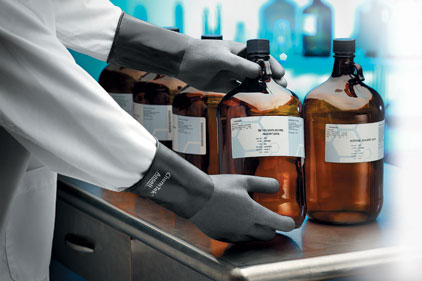A hand injury, however, can suddenly disrupt good hand health, depending on the injury’s severity. Hands that are uncomfortable due to any number of factors can also slow a worker’s productivity. Because hands are needed for everything we do — eat, work, play — the impact of a hand injury can have far-reaching effects on a worker’s life.
Hand injuries
The types of injuries or hazards workers usually incur fall into four primary categories: mechanical-related injuries, temperature burns, physiochemical-related injuries and musculoskeletal injuries. Some injuries may be minor and require a bandage or anti-bacterial cream. Others may involve significant medical treatment, with lost time on the job amounting to days, months or even years.
Mechanical-related injuries are the most common on-the-job hand injuries and include lacerations, abrasions and puncture, pinch or crush wounds. Injury severity may vary depending on the work environment, the size of the product being produced and the task performed when the worker is injured. Most of these injuries are preventable when workers wear proper hand protection and follow safe working protocols.
Temperature burns typically result from excessive heat or cold and usually vary in their degree of severity. High temperature burns, for example, may be linked to contact with heat-treated or welded materials, electric arc or even friction related injuries. Low temperature burns generally result from contact with various refrigerants or exposure during extreme working conditions. Temperature-related injuries are often preventable and require a safe working environment and protocol, and the proper use of protective gloves.
Physiochemical-related injuries typically result from severe or repeated chemical exposure or the use of gloves that do not allow the worker’s skin to breathe or manage perspiration. Chemical burns are very different from heat burns because they generally produce no heat, although the worker is likely to experience a burning sensation. Chemical burn severity will depend on the concentration of the substance to which the worker is exposed and length of exposure. Chemicals that are absorbed by the skin can be extremely dangerous and even life-threatening.
Contact dermatitis is a physiochemical-related and debilitating hand injury that can result from excessive or repeated perspiration while a worker is wearing gloves. Such injuries are often worse if accompanied by chemical or pathogen exposure. Skin may crack, bleed or become infected if hand hygiene practices are not followed and workers do not wear appropriate hand protection products.
Musculoskeletal injuries are often related to repetitive strain, excessive vibration, nonergonomic workstations, etc. Workers suffer from more of these types of injuries than ever before. Using the proper hand protection products — gloves that fit and feel like a second skin and allow maximum flexibility — can help reduce the risk of this type of injury.
The risk of musculoskeletal injuries increases when the wrong glove is used for a task. An improperly selected or designed glove could actually increase the potential for musculoskeletal ailments. Gloves, for example, that do not offer sufficient grip in dry or wet applications are more likely to promote this type of injury. Products are available that include materials with a degree of surface roughness to promote strong grip force.
Bacterial growth
Bacteria are present on everyone’s hands and skin. In the simplest terms, some are good bacteria (skin flora may prevent pathogenic organisms from colonizing the skin surface), while other bacteria are dangerous and can induce infection such as Methicillin-resistant Staphylococcus aureus (MRSA) infection, which is caused by a strain of staph bacteria that has become resistant to antibiotics generally used to treat ordinary staph infections.
Frequent hand washing or a hand hygiene program can often prevent bacterial infection. In addition, gloves and hand gels are now available that prevent bacterial growth. These products should be selected based on the nature of the use, the type of “bugs” targeted and the kill effectiveness.
In the food processing industry, for example, gloves are available that include yarns or coatings with antimicrobial properties. These products demonstrate kill effectiveness for a range of food-borne pathogens even after they are washed in chlorine bleach.
How to treat hand injuries
Hand injuries should always be examined and treated. Like injuries on any part of the body, a hand injury or skin condition that is not cared for can become worse and may cause long-term health issues.
Dr. Elliott Sorene, for example, an orthopedic consultant and hand and upper limb surgeon in the United Kingdom, indicated that during the early stages of Carpal Tunnel Syndrome (CTS), nerve symptoms are reversible. But, if left untreated, CTS can result in thumb muscle wasting, chronic hand weakness and permanent numbness in the median nerve area of the hand, which can be disabling.
Wounds — whether caused by irritation, chafing or laceration — should always receive care because they create open access to the body for bacterial and viral infiltration, which can cause infections. Left untreated, infections can travel through the body and affect various organs, which, of course, can lead to expensive medical care and extensive time away from work.
Handling hand care
Hand injuries run the gamut from insignificant to severe. They should always be examined and treated as necessary to prevent infection or more serious injury.
Proper hand protection is essential to maintain healthy hands. To select the right gloves, it is important to clearly define the product’s performance requirements. The gloves selected must be suited to the specific application, duty cycle and conditions of the user.
Size and fit are critical for ongoing use, ergonomic benefits and maximized productivity. Skin health should always be considered and gloves selected that include advanced materials to promote healthy skin.
Lastly, the glove selected should have a proven performance record. Always verify the product is made with quality materials that will help provide the level of protection required to the end of the product’s service life.
